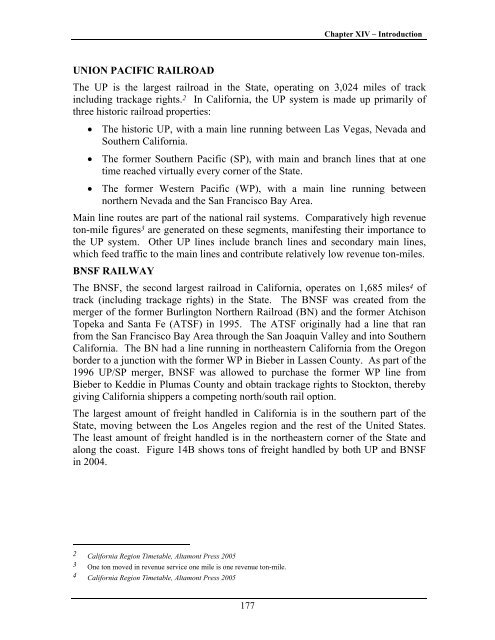California State Rail Plan 2005-06 to 2015-16
California State Rail Plan 2005-06 to 2015-16
California State Rail Plan 2005-06 to 2015-16
You also want an ePaper? Increase the reach of your titles
YUMPU automatically turns print PDFs into web optimized ePapers that Google loves.
Chapter XIV – Introduction<br />
UNION PACIFIC RAILROAD<br />
The UP is the largest railroad in the <strong>State</strong>, operating on 3,024 miles of track<br />
including trackage rights. 2 In <strong>California</strong>, the UP system is made up primarily of<br />
three his<strong>to</strong>ric railroad properties:<br />
• The his<strong>to</strong>ric UP, with a main line running between Las Vegas, Nevada and<br />
Southern <strong>California</strong>.<br />
• The former Southern Pacific (SP), with main and branch lines that at one<br />
time reached virtually every corner of the <strong>State</strong>.<br />
• The former Western Pacific (WP), with a main line running between<br />
northern Nevada and the San Francisco Bay Area.<br />
Main line routes are part of the national rail systems. Comparatively high revenue<br />
<strong>to</strong>n-mile figures 3 are generated on these segments, manifesting their importance <strong>to</strong><br />
the UP system. Other UP lines include branch lines and secondary main lines,<br />
which feed traffic <strong>to</strong> the main lines and contribute relatively low revenue <strong>to</strong>n-miles.<br />
BNSF RAILWAY<br />
The BNSF, the second largest railroad in <strong>California</strong>, operates on 1,685 miles 4 of<br />
track (including trackage rights) in the <strong>State</strong>. The BNSF was created from the<br />
merger of the former Burling<strong>to</strong>n Northern <strong>Rail</strong>road (BN) and the former Atchison<br />
Topeka and Santa Fe (ATSF) in 1995. The ATSF originally had a line that ran<br />
from the San Francisco Bay Area through the San Joaquin Valley and in<strong>to</strong> Southern<br />
<strong>California</strong>. The BN had a line running in northeastern <strong>California</strong> from the Oregon<br />
border <strong>to</strong> a junction with the former WP in Bieber in Lassen County. As part of the<br />
1996 UP/SP merger, BNSF was allowed <strong>to</strong> purchase the former WP line from<br />
Bieber <strong>to</strong> Keddie in Plumas County and obtain trackage rights <strong>to</strong> S<strong>to</strong>ck<strong>to</strong>n, thereby<br />
giving <strong>California</strong> shippers a competing north/south rail option.<br />
The largest amount of freight handled in <strong>California</strong> is in the southern part of the<br />
<strong>State</strong>, moving between the Los Angeles region and the rest of the United <strong>State</strong>s.<br />
The least amount of freight handled is in the northeastern corner of the <strong>State</strong> and<br />
along the coast. Figure 14B shows <strong>to</strong>ns of freight handled by both UP and BNSF<br />
in 2004.<br />
2 <strong>California</strong> Region Timetable, Altamont Press <strong>2005</strong><br />
3 One <strong>to</strong>n moved in revenue service one mile is one revenue <strong>to</strong>n-mile.<br />
4 <strong>California</strong> Region Timetable, Altamont Press <strong>2005</strong><br />
177













